Abstract
A double antibody radioimmunoassay has been developed to measure thyroglobulin in rat (RTg) serum. The lowest detectable quantity measurable was 5.0 ng/ml. Specificity was documented by: (a) fall in serum RTg to undetectable levels after thyroid ablation; (b) the fact that L-thyroxine, D-thyroxine, L-triiodothyronine, D-triiodothyronine, triiodothyroacetic acid, tetraiodothyroacetic acid, triiodothyropropionic acid, moniodotyrosine, diiodotyrosine, and human thyroglobulin (HTg) in concentrations up to 40,000 ng per tube did not cross-react in the assay; (c) the demonstration that constant levels of serum RTg were observed while varying amounts of serum (criterion of parallelism) were introduced in the assay. The mean RTg concentration in tail vein blood of adult Sprague-Dawley rats were 101.5 +/- 13.0 ng/ml (SEM) (n=21); values ranged from 12.0 to 258.0 ng/ml. Chronic administration of a high-iodine diet (HID) did not affect serum thyroglobulin levels. Chronic administration of a low-iodine diet (LID) and propylthiouracil (PTU) led to a statistically significant increase in serum RTg that was accompanied by a significant rise in serum thyrotropin (rTSH). Serum thyroxine (T4) administered to normal rats for 14 days (20 mug/day subcutaneously) depressed serum RTg concentration from a mean level of 119.4 +/- 17.5 ng/ml (n=19) to a mean of 35.0 +/- 0.27 ng/ml (n=19) (P less than 0.001). While rats were on continuous T4 suppression, bovine thyroid-stimulating hormone (bTSH) given intravenously (2 IU) resulted in a mean maximal increment of RTg of 332.0 +/- 81.5 ng/ml (n=6) at 24 h. IgC-(LATS) long-acting thyroid stimulatory injected intravenously resulted in a mean maximal increment of RTg concentration at 96 h of 87.2 +/- 14.3 ng/ml (n=5). Normal IgG had no statistical significant effect of RTg levels at any time after the injection.
Full text
PDF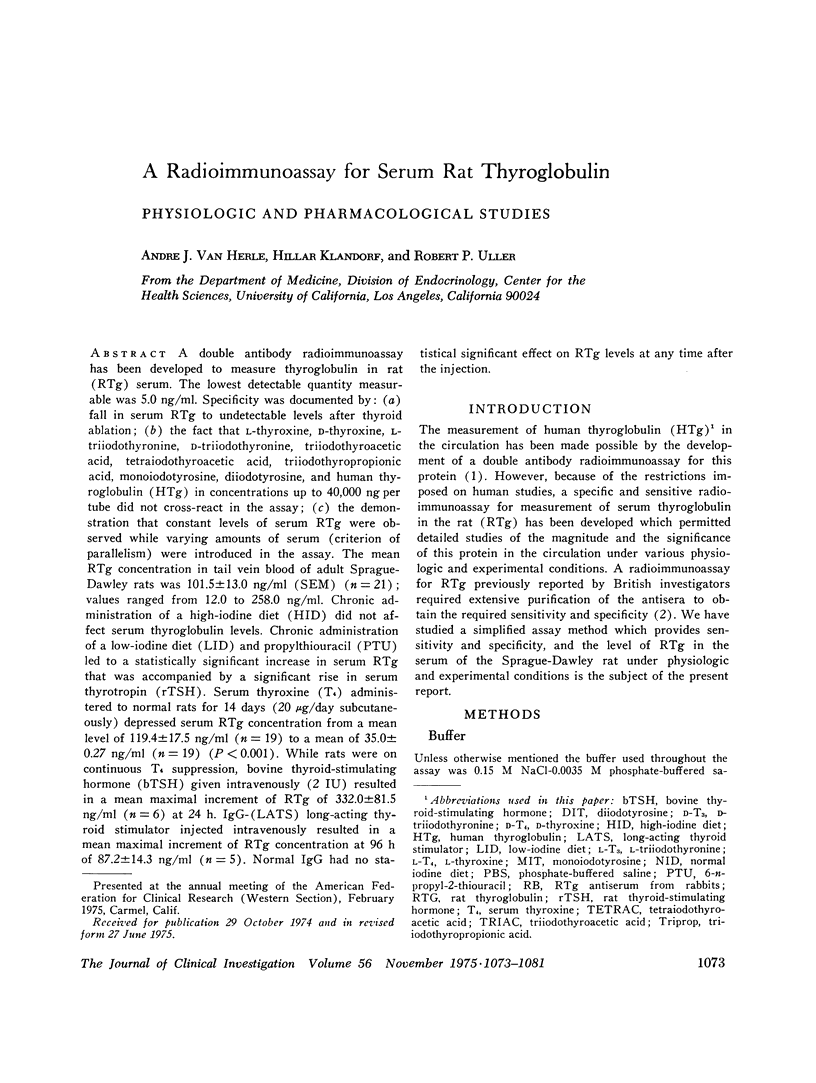
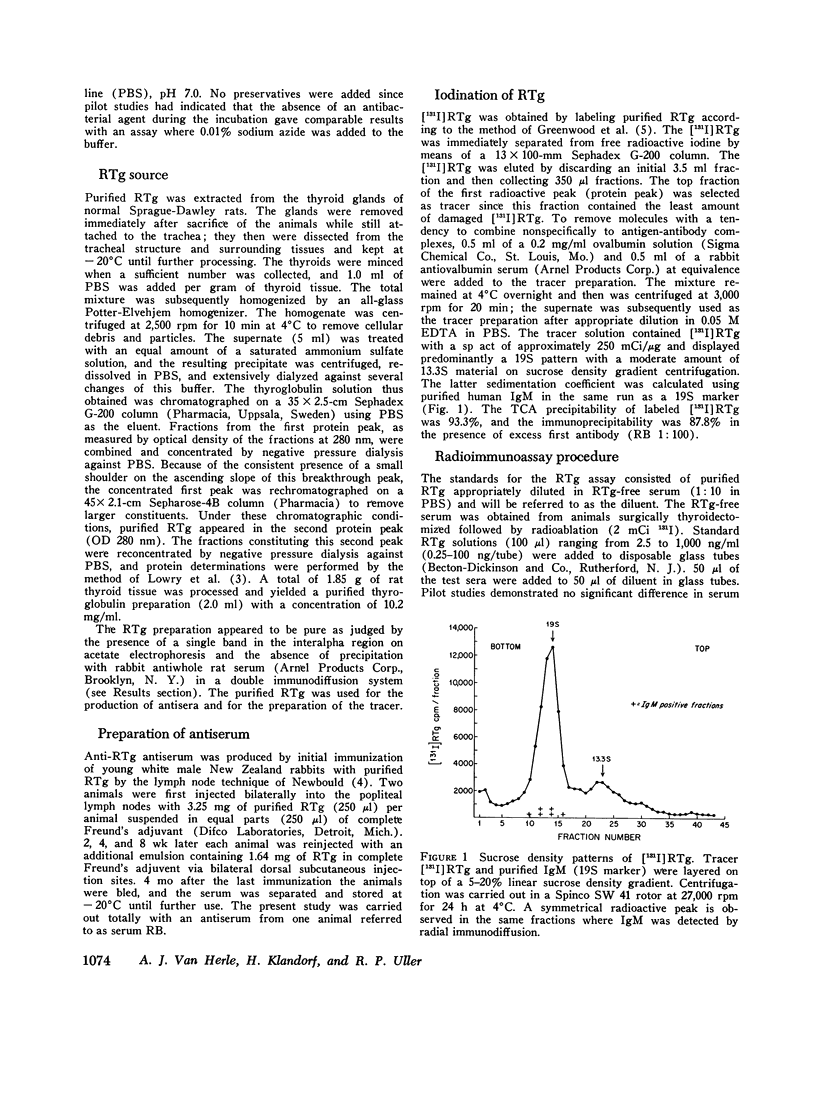
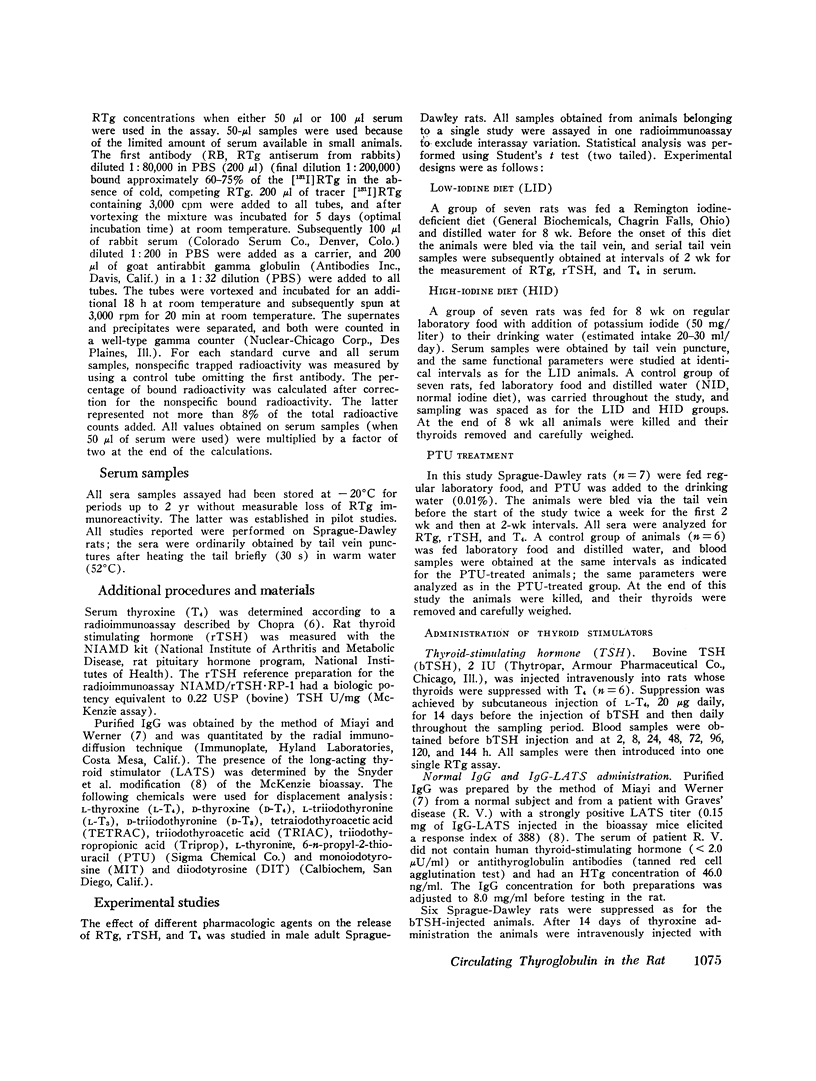
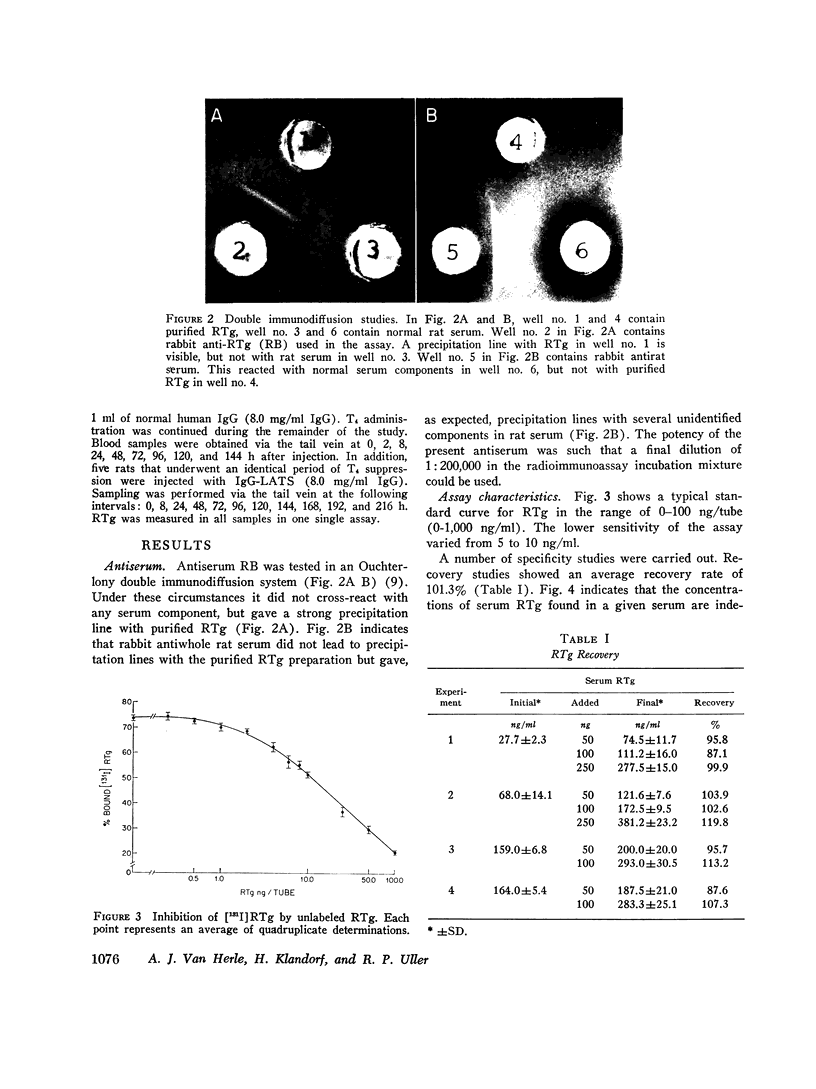
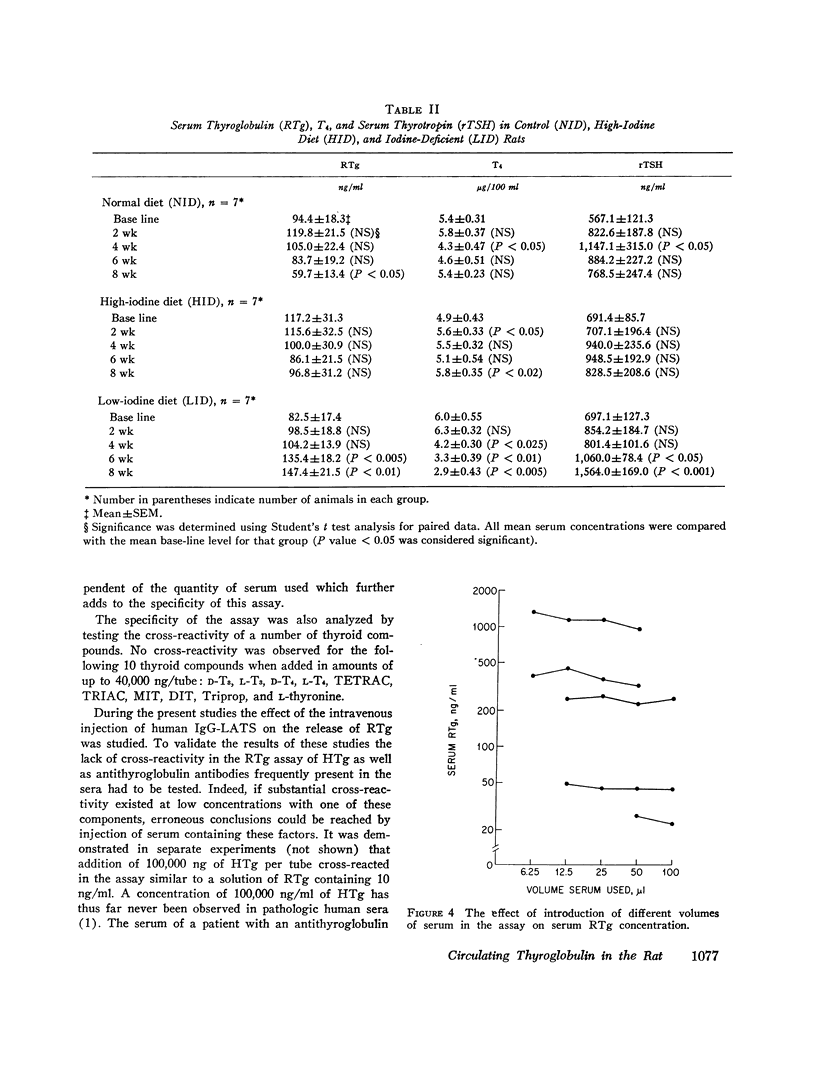
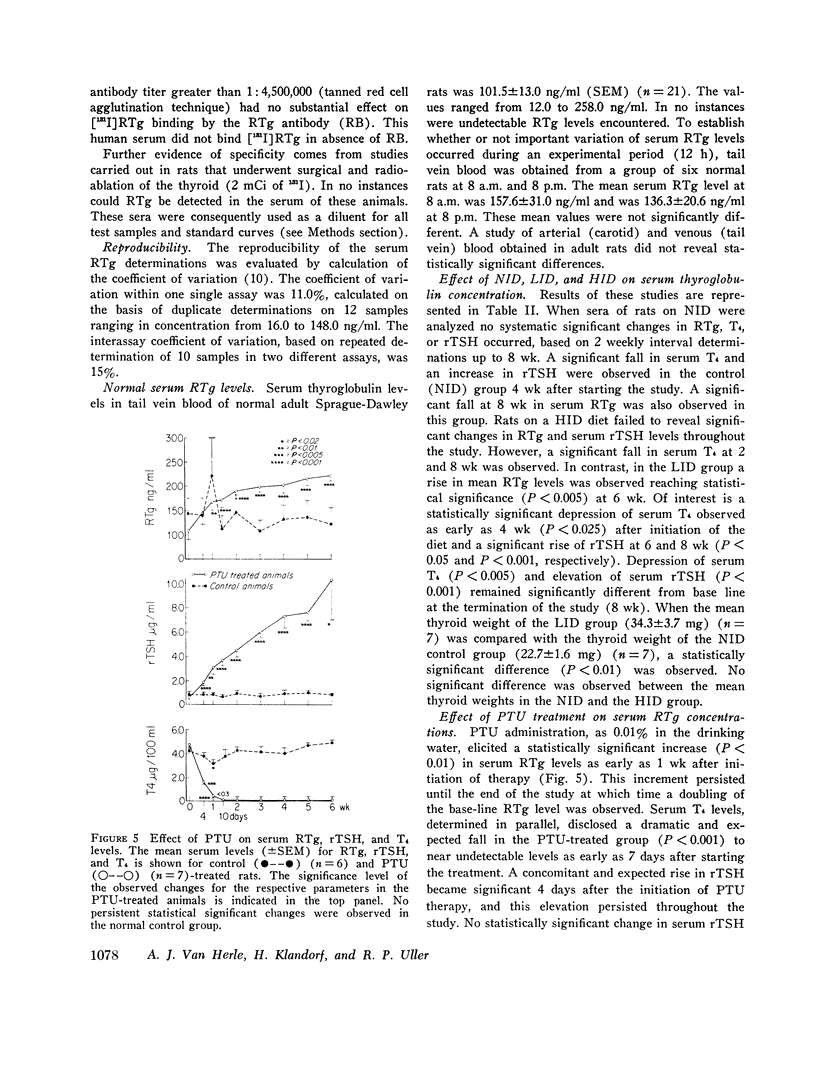
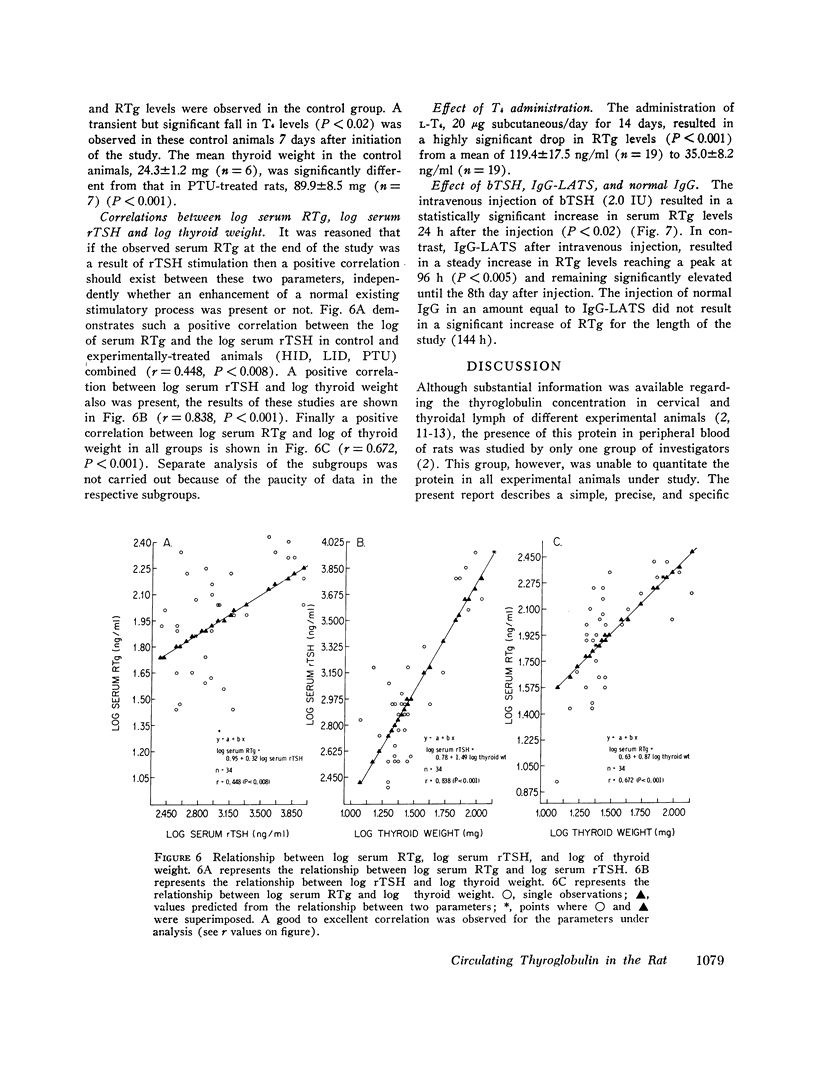
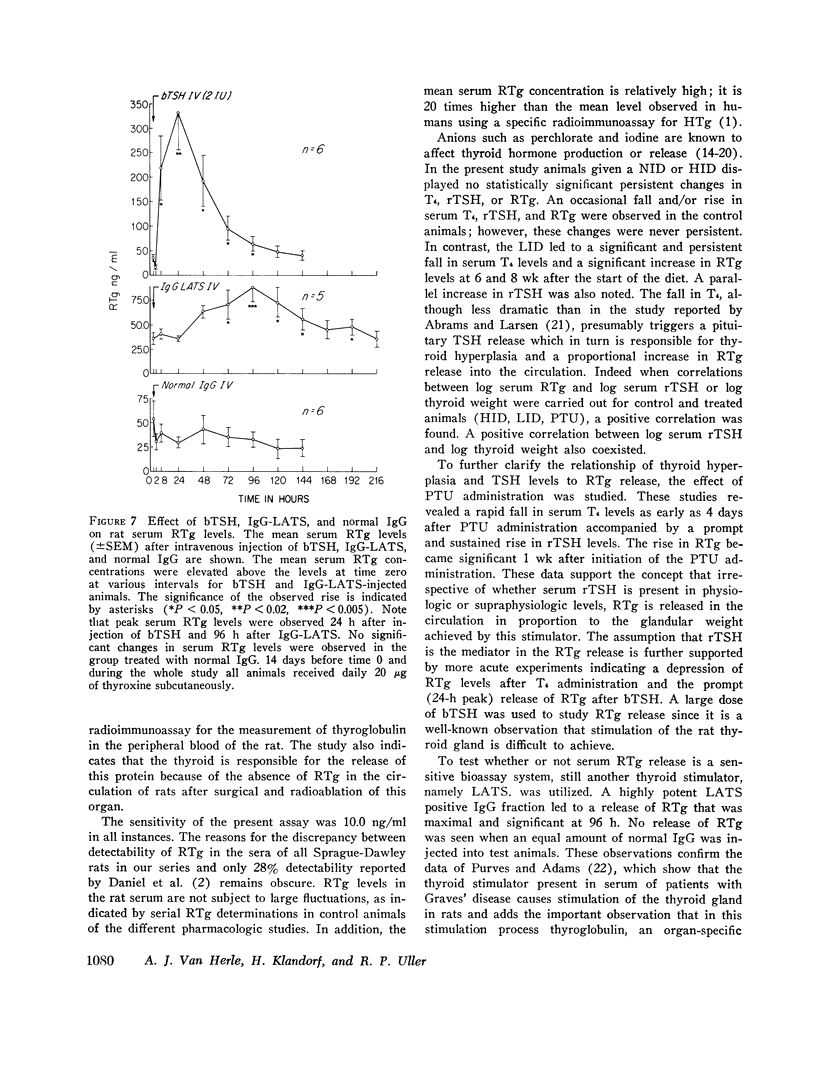

Images in this article
Selected References
These references are in PubMed. This may not be the complete list of references from this article.
- Abrams G. M., Larsen P. R. Triiodothyronine and thyroxine in the serum and thyroid glands of iodine-deficient rats. J Clin Invest. 1973 Oct;52(10):2522–2531. doi: 10.1172/JCI107443. [DOI] [PMC free article] [PubMed] [Google Scholar]
- Chopra I. J. A radioimmunoassay for measurement of thyroxine in unextracted serum. J Clin Endocrinol Metab. 1972 Jun;34(6):938–947. doi: 10.1210/jcem-34-6-938. [DOI] [PubMed] [Google Scholar]
- DEGROOT L. J., GREER M. A. The effect of stable iodide on thyroid secretion in man. Metabolism. 1956 Nov;5(6 Pt 1):682–696. [PubMed] [Google Scholar]
- DOBYNS B. M., HIRSCH E. Z. Iodinated compounds in the lymphatic pathways leading from the thyroid. J Clin Endocrinol Metab. 1956 Jan;16(1):153–155. doi: 10.1210/jcem-16-1-153. [DOI] [PubMed] [Google Scholar]
- Daniel P. M., Plaskett L. G., Pratt O. E. The lymphatic and venous pathways for the outflow of thyroxine, iodoprotein and inorganic iodide from the thyroid gland. J Physiol. 1967 Jan;188(1):25–44. doi: 10.1113/jphysiol.1967.sp008121. [DOI] [PMC free article] [PubMed] [Google Scholar]
- Daniel P. M., Pratt O. E., Roitt I. M., Torrigiani G. The release of thyroglobulin from the thyroid gland into thyroid lymphatics; the identification of thyroglobulin in the thyroid lymph and in the blood of monkeys by physical and immunological methods and its estimation by radioimmunoassay. Immunology. 1967 May;12(5):489–504. [PMC free article] [PubMed] [Google Scholar]
- Daniel P. M., Pratt O. E., Roitt I. M., Torrigiani G. Thyroglobulin in the lymph draining from the thyroid gland and in the peripheral blood of rats. Q J Exp Physiol Cogn Med Sci. 1967 Apr;52(2):184–199. doi: 10.1113/expphysiol.1967.sp001901. [DOI] [PubMed] [Google Scholar]
- GOLDSMITH R. E., EISELE M. L. The effect of iodide on the release of thyroid hormone in hyperthyroidism. J Clin Endocrinol Metab. 1956 Jan;16(1):130–137. doi: 10.1210/jcem-16-1-130. [DOI] [PubMed] [Google Scholar]
- GREENWOOD F. C., HUNTER W. M., GLOVER J. S. THE PREPARATION OF I-131-LABELLED HUMAN GROWTH HORMONE OF HIGH SPECIFIC RADIOACTIVITY. Biochem J. 1963 Oct;89:114–123. doi: 10.1042/bj0890114. [DOI] [PMC free article] [PubMed] [Google Scholar]
- LOWRY O. H., ROSEBROUGH N. J., FARR A. L., RANDALL R. J. Protein measurement with the Folin phenol reagent. J Biol Chem. 1951 Nov;193(1):265–275. [PubMed] [Google Scholar]
- Miyai K., Werner S. C. Concentration of long-acting thyroid stimulator (LATS) by subfractionation of gamma G globulin from Graves' disease serum. J Clin Endocrinol Metab. 1966 May;26(5):504–512. doi: 10.1210/jcem-26-5-504. [DOI] [PubMed] [Google Scholar]
- PURVES H. D., ADAMS D. D. Thyroid-stimulating hormone. Br Med Bull. 1960 May;16:128–132. doi: 10.1093/oxfordjournals.bmb.a069811. [DOI] [PubMed] [Google Scholar]
- RICHARDS J. B., INGBAR S. H. The effects of propylthiouracil and perchlorate on the biogenesis of thyroid hormone. Endocrinology. 1959 Aug;65(2):198–207. doi: 10.1210/endo-65-2-198. [DOI] [PubMed] [Google Scholar]
- SNYDER N. J., GREEN D. E., SOLOMON D. H. GLUCOCORTICOID-INDUCED DISAPPEARANCE OF LONG-ACTING THYROID STIMULATOR IN THE OPHTHALMOPATHY OF GRAVES' DISEASE. J Clin Endocrinol Metab. 1964 Nov;24:1129–1135. doi: 10.1210/jcem-24-11-1129. [DOI] [PubMed] [Google Scholar]
- SOLOMON D. H. Factors affecting the fractional rate of release of radioiodine from the thyroid gland in man. Metabolism. 1956 Nov;5(6 Pt 1):667–681. [PubMed] [Google Scholar]
- Van Herle A. J., Uller R. P., Matthews N. I., Brown J. Radioimmunoassay for measurement of thyroglobulin in human serum. J Clin Invest. 1973 Jun;52(6):1320–1327. doi: 10.1172/JCI107303. [DOI] [PMC free article] [PubMed] [Google Scholar]
- Yamamoto K., Onaya T., Yamada T., Kotani M. Inhibitory effect of excess iodide on thyroid hormone release as measured by intracellular colloid droplets. Endocrinology. 1972 Apr;90(4):986–991. doi: 10.1210/endo-90-4-986. [DOI] [PubMed] [Google Scholar]



